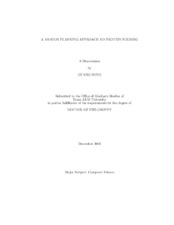| dc.description.abstract | Protein folding is considered to be one of the grand challenge problems in biology. Protein folding refers to how a protein's amino acid sequence, under certain physiological conditions, folds into a stable close-packed three-dimensional structure known as the native state. There are two major problems in protein folding. One, usually called protein structure prediction, is to predict the structure of the protein's native state given only the amino acid sequence. Another important and strongly related problem, often called protein folding, is to study how the amino acid sequence dynamically transitions from an unstructured state to the native state. In this dissertation, we concentrate on the second problem. There are several approaches that have been applied to the protein folding problem, including molecular dynamics, Monte Carlo methods, statistical mechanical models, and lattice models. However, most of these approaches suffer from either overly-detailed simulations, requiring impractical computation times, or overly-simplified models, resulting in unrealistic solutions.
In this work, we present a novel motion planning based framework for studying protein folding. We describe how it can be used to approximately map a protein's energy landscape, and then discuss how to find approximate folding pathways and kinetics on this approximate energy landscape. In particular, our technique can produce potential energy landscapes, free energy landscapes, and many folding pathways all from a single roadmap. The roadmap can be computed in a few hours on a desktop PC using a coarse potential energy function. In addition, our motion planning based approach is the first simulation method that enables the study of protein folding kinetics at a level of detail that is appropriate (i.e., not too detailed or too coarse) for capturing possible 2-state and 3-state folding kinetics that may coexist in one protein. Indeed, the unique ability of our method to produce large sets of unrelated folding pathways may potentially provide crucial insight into some aspects of folding kinetics that are not available to other theoretical techniques. | en |


